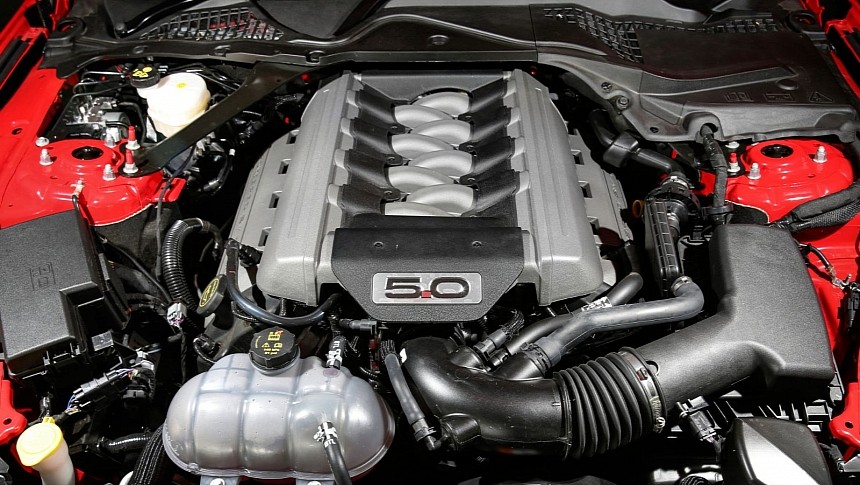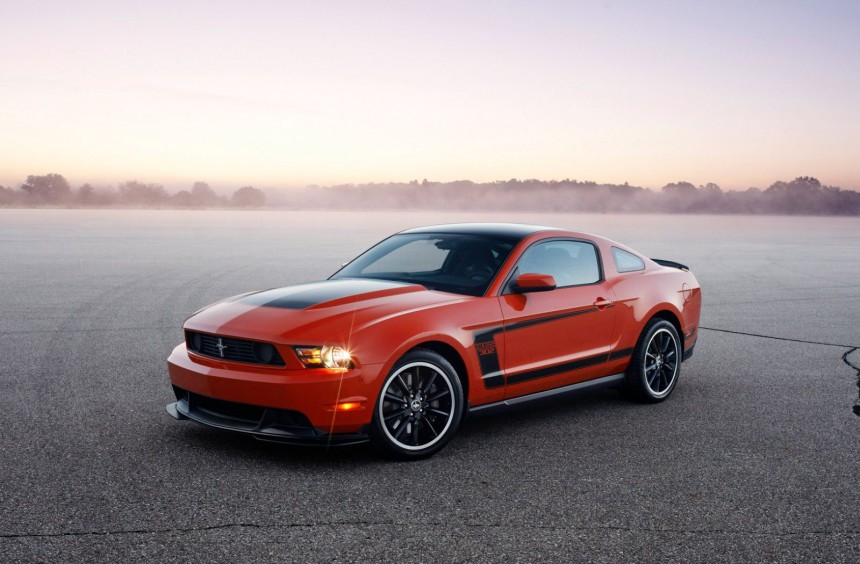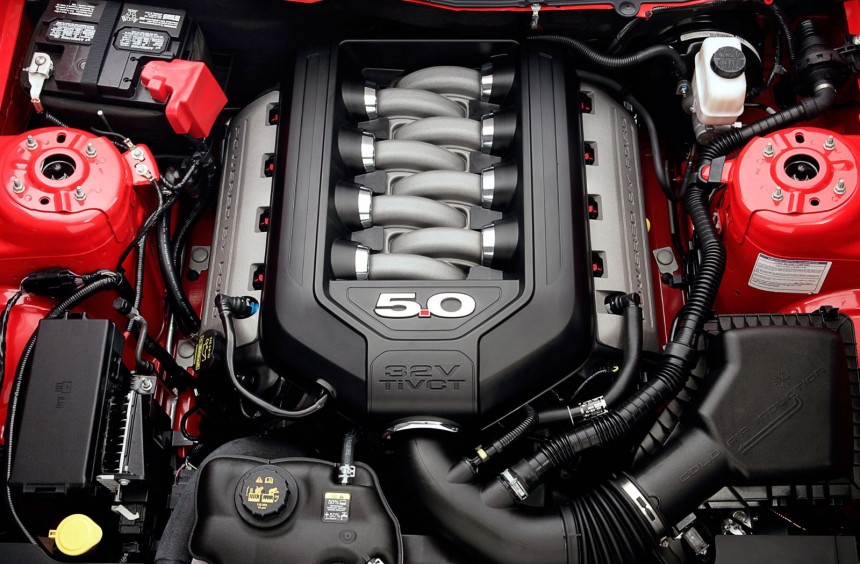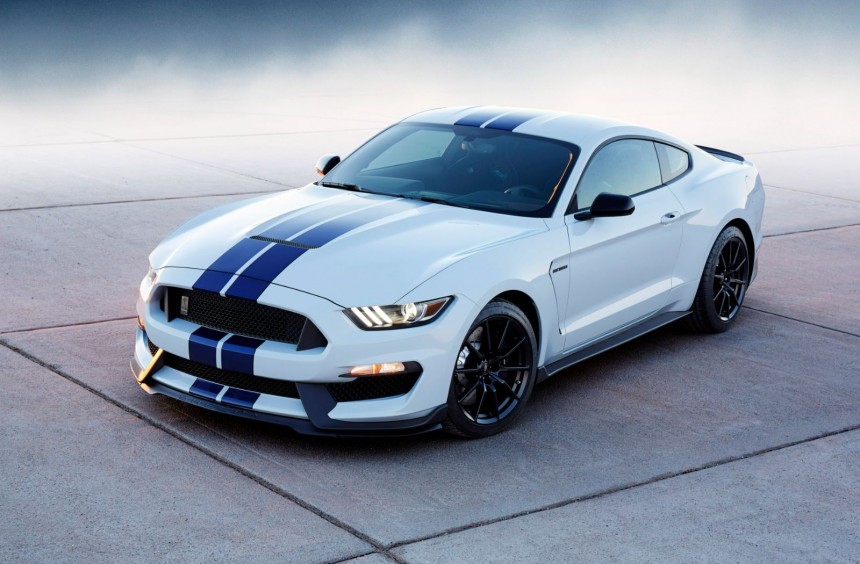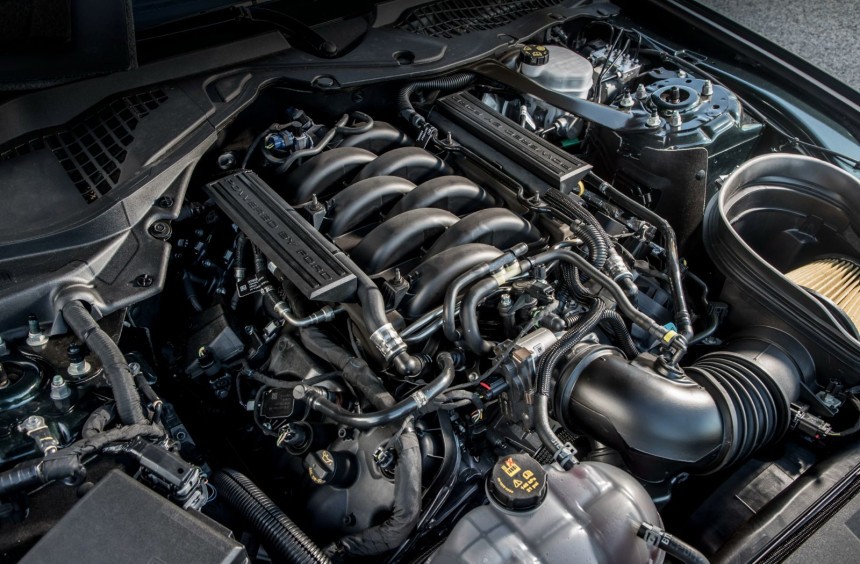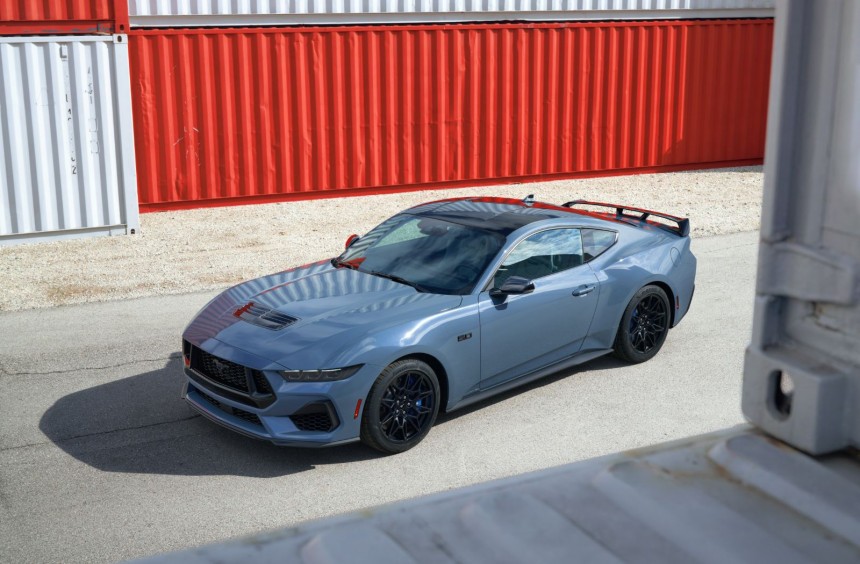Though not entirely new nor revolutionary, the Coyote signaled Ford's long-awaited return to high-horsepower muscle car madness, becoming one of the company's most iconic production V8s.
During the '60s, a large portion of the American car-buying public began developing an addiction to high-performance rides, pushing carmakers to create ever-larger, more powerful V8 engines and fitting them into virtually every model they sold.
For the folks at Ford, the demand for high-horsepower tire shredders meant that the new and popular Mustang pony car (and its Mercury Cougar sibling) had to receive the muscle car treatment to keep high-performance enthusiasts engaged. Therefore, the car evolved rapidly, and by 1970, it was available with a wide range of powerful V8s.
Unfortunately, high insurance rates, stringent emission standards, and a looming oil crisis drew the curtain on the muscle car phenomenon far sooner than anyone would've liked.
Most iconic muscle car nameplates (including the Mustang) survived, but the powerful V8s that made them icons didn't. Despite efforts to deliver versions of the 'Stang that catered to performance enthusiasts with sportier editions and subtly more powerful engines available during the mid-'70s and '80s, performance was far from the standards of the late-'60s or early-'70s.
High-powered Mustang fanatics had to wait until the mid-2000s to get a factory model equipped with a V8 that made over the 300-hp mark. While this was a welcomed development, it didn't exactly mean that the Mustang was a thoroughbred muscle car once again.
However, the Ford Modular V8 platform responsible for this improvement would be taken to a different level of performance starting with 2010 when the Coyote version was introduced. Along with Chrysler's third-gen HEMI (which eventually morphed into the rabid Hellcat), and Chevy's new-age small blocks, the Coyote signaled the start of a new muscle car era that continues well into the age of electrification.
Nowadays, the Coyote has become one of Ford's most epic performance V8s. While the Mustang's main rivals (the Camaro and Challenger) are set to be discontinued, making way to electric models, America's most popular pony car welcomes its seventh ICE-powered iteration with the latest evolution of the Coyote V8 at its core.
The Coyote was introduced in late-2010, replacing the 5.4-liter Modular under the hood of the 2011 S197 Mustang GT. While it was bigger, more powerful, and earned its moniker, the engine was not entirely new but an evolution of its predecessor.
Architecture-wise, it featured a cast aluminum block and heads with a composite intake manifold, just like the 4.6-liter. Even the 3.937-inch(100 mm) bore spacing and 8.937-inch (227.0 mm) deck height was carried over, but, under closer inspection, the Coyote was a different monster.
The block was strengthened using webbing rather than thickening the walls during the casting process. Though this limited the bore and stroke to 92.7mm x 92.2mm (and thus a displacement of 5.0 liters), it ultimately made the engine easier to package in the S197 chassis and reduced manufacturing costs.
To compensate for the small displacement increase and extract more power, engineers completely redesigned the cylinder heads. Instead of the three-valve, single overhead cam layout of the outgoing 5.4, the new Coyote received modern, four-valve DOHC (dual overhead camshaft) heads - a formula that basically gave the engine superpowers.
The feature that made the new heads special was Ford's innovative Twin Independent Variable Cam Timing (Ti-VCT) system. Used for the first time on a V8, the system allowed the intake and exhaust camshafts to move independently, producing a dynamic lobe separation angle (LSA).
Compared to more traditional V8s, where cams with either a wide or narrow LSA influenced the power curve and resulted in some compromise (power loss at either low or high RPMs), the Ti-VCT adjusted the amount of time the intake and exhaust valves were concomitantly open according to engine speed and cylinder pressure. In simpler terms, it allowed the engine to deliver as much power as possible at both lower and higher RPMs, all while improving fuel economy and emissions.
In the Mustang GT, the Gen 1 Coyote was rated at a healthy 412 hp (increasing to 420 hp in 2012) and 390 lb-ft (528.7 Nm) of peak twist, available as low as 4,250 rpm - figures that made it a true 21st-century muscle car engine.
There was also a slightly beefed-up version of the Coyote installed in the revived Boss 302. Internally codenamed Road Runner, this special version of the Coyote received several improvements, such as CNC ported heads cast in 356 aluminum, a beefier crankshaft, hotter exhaust cams, sodium-filled exhaust valves, stronger, sinter-forged conrods, forged aluminum pistons, and a high-rise intake with shorter runners. All these goodies resulted in 444 hp and 380 lb-ft (515 Nm) of torque.
In December 2013, Ford unveiled the new, sixth-generation Mustang (S550), kicking-off production about seven months later.
While the base Mustang made the somewhat controversial switch from a V6 to the EcoBoost turbocharged inline-four, the GT continued to use the mighty Coyote - albeit with a few upgrades that increased output to 435 hp and 400 lb-ft (542 Nm) of torque.
The Gen 2's cylinder heads received larger intake and exhaust valves, revised cams, an improved Ti-VCT system, stiffer valve springs, or upgraded head bolts. Moreover, inside the block, the standard Gen 1 conrods were replaced with the sinter-forged versions of the Road Runner.
The S550 generation also saw the return of the Shelby GT350 nameplate in 2015. Although not the work of Shelby American like its original 1960s counterpart, the modern GT350 (and the more track-focused GT350R) received a monster of an engine based on the Coyote.
Enlarged to 5.2 liters and dubbed Voodoo, this hand-assembled naturally-aspirated powerplant was equipped with a flat-plane crankshaft, bespoke cylinder heads, and a different intake, all of which increased output to 526 hp and 429 lb-ft (582 Nm).
In 2018, Ford engineers decided to give the Coyote another significant list of upgrades. Codenamed Gen 3, the newest version of the powerful V8 gained a high-pressure direct injection system, which didn't replace but worked alongside the low-pressure port injection system of the previous generations.
Furthermore, the bore size was slightly increased from 92.7 mm to 93 mm, resulting in a displacement of 5,038 cc (307 ci) insted of 4,951 cc (302 ci). This was done to make room for Plasma Transferred Wire Arc (PTWA) liners borrowed from the Voodoo.
The heads were also revised, receiving larger intake and exhaust valves, an increase of the lobe lift on the exhaust cams, and a thoroughly upgraded Ti-VCT system.
Courtesy of these upgrades, the V8 in the Mustang GT could now rev higher (7,500 instead of 6,500 rpm), making 460 hp and 420 lb-ft (569 Nm) of torque - but it wasn't the most powerful Gen 3 Coyote.
To celebrate the 50th anniversary of the movie Bullitt in which a modified first-gen Mustang starred, Ford introduced a limited-edition of the S550 GT called - you guessed it! - Bullitt. Under its hood, the green mean-machine featured a Gen 3 Coyote with a larger throttle body a modified and intake sourced from the GT350 Voodoo. Also used in the 2021 Mach 1 and rated at 480 hp, this version became the most potent naturally-aspirated Gen 3 Coyote.
In 2020, Ford unleased the S550-based GT500, and with it came the apex predator of the Gen 3 lineup. Fittingly named Predator, the rabid V8 was designed as a mix between the Voodoo and the Gen 3 Coyote; it features a cross-plane crank and a supercharger (among other goodies), spitting out 760 hp and 625 lb-ft (847 Nm) of torque inside the GT500's engine bay. It is also used in the F-150 Raptor R but with a different tune rated at 700 hp 640 lb-ft (870 Nm) of torque.
While Chrysler and General Motors recently announced that their pony cars had reached the end of the line, Ford decided to continue offering a new, ICE-powered Mustang from 2024.
Much to everyone's surprise (and Mustang enthusiasts' relief), the seventh generation (S650) is set to debut the Gen 4 Coyote, which will receive a revised 4-in-1 exhaust manifold and a new intake with dual 80 mm throttle bodies.
According to the carmaker, it will deliver 480 hp and 415 lb-ft (563 Nm) in the standard GT, 486 hp and 418 lb-ft (567 Nm) when equipped with a new Active Performance Exhaust option, and 500 hp and 418 lb-ft (567 Nm) in the all-new Dark Horse model.
Since its introduction, the Coyote V8 has undeniably made the Mustang great again. It also contributed to the rebirth of thoroughbred, factory-built muscle cars after a four-decade-long wait. Though the era of electrification has made it an endangered species, it will stubbornly continue to thrill muscle car enthusiasts - at least for the foreseeable future.
If you want to learn more about this legendary engine, we recommend watching the YouTube video below by Dust Runners Automotive Journal.
For the folks at Ford, the demand for high-horsepower tire shredders meant that the new and popular Mustang pony car (and its Mercury Cougar sibling) had to receive the muscle car treatment to keep high-performance enthusiasts engaged. Therefore, the car evolved rapidly, and by 1970, it was available with a wide range of powerful V8s.
Unfortunately, high insurance rates, stringent emission standards, and a looming oil crisis drew the curtain on the muscle car phenomenon far sooner than anyone would've liked.
Most iconic muscle car nameplates (including the Mustang) survived, but the powerful V8s that made them icons didn't. Despite efforts to deliver versions of the 'Stang that catered to performance enthusiasts with sportier editions and subtly more powerful engines available during the mid-'70s and '80s, performance was far from the standards of the late-'60s or early-'70s.
High-powered Mustang fanatics had to wait until the mid-2000s to get a factory model equipped with a V8 that made over the 300-hp mark. While this was a welcomed development, it didn't exactly mean that the Mustang was a thoroughbred muscle car once again.
However, the Ford Modular V8 platform responsible for this improvement would be taken to a different level of performance starting with 2010 when the Coyote version was introduced. Along with Chrysler's third-gen HEMI (which eventually morphed into the rabid Hellcat), and Chevy's new-age small blocks, the Coyote signaled the start of a new muscle car era that continues well into the age of electrification.
Nowadays, the Coyote has become one of Ford's most epic performance V8s. While the Mustang's main rivals (the Camaro and Challenger) are set to be discontinued, making way to electric models, America's most popular pony car welcomes its seventh ICE-powered iteration with the latest evolution of the Coyote V8 at its core.
A worthy replacement for the aging 4.6-liter Modular
Architecture-wise, it featured a cast aluminum block and heads with a composite intake manifold, just like the 4.6-liter. Even the 3.937-inch(100 mm) bore spacing and 8.937-inch (227.0 mm) deck height was carried over, but, under closer inspection, the Coyote was a different monster.
The block was strengthened using webbing rather than thickening the walls during the casting process. Though this limited the bore and stroke to 92.7mm x 92.2mm (and thus a displacement of 5.0 liters), it ultimately made the engine easier to package in the S197 chassis and reduced manufacturing costs.
DOHC, Ti-VCT superpowers
The feature that made the new heads special was Ford's innovative Twin Independent Variable Cam Timing (Ti-VCT) system. Used for the first time on a V8, the system allowed the intake and exhaust camshafts to move independently, producing a dynamic lobe separation angle (LSA).
Compared to more traditional V8s, where cams with either a wide or narrow LSA influenced the power curve and resulted in some compromise (power loss at either low or high RPMs), the Ti-VCT adjusted the amount of time the intake and exhaust valves were concomitantly open according to engine speed and cylinder pressure. In simpler terms, it allowed the engine to deliver as much power as possible at both lower and higher RPMs, all while improving fuel economy and emissions.
In the Mustang GT, the Gen 1 Coyote was rated at a healthy 412 hp (increasing to 420 hp in 2012) and 390 lb-ft (528.7 Nm) of peak twist, available as low as 4,250 rpm - figures that made it a true 21st-century muscle car engine.
There was also a slightly beefed-up version of the Coyote installed in the revived Boss 302. Internally codenamed Road Runner, this special version of the Coyote received several improvements, such as CNC ported heads cast in 356 aluminum, a beefier crankshaft, hotter exhaust cams, sodium-filled exhaust valves, stronger, sinter-forged conrods, forged aluminum pistons, and a high-rise intake with shorter runners. All these goodies resulted in 444 hp and 380 lb-ft (515 Nm) of torque.
Becoming even better inside a new chassis
While the base Mustang made the somewhat controversial switch from a V6 to the EcoBoost turbocharged inline-four, the GT continued to use the mighty Coyote - albeit with a few upgrades that increased output to 435 hp and 400 lb-ft (542 Nm) of torque.
The Gen 2's cylinder heads received larger intake and exhaust valves, revised cams, an improved Ti-VCT system, stiffer valve springs, or upgraded head bolts. Moreover, inside the block, the standard Gen 1 conrods were replaced with the sinter-forged versions of the Road Runner.
The S550 generation also saw the return of the Shelby GT350 nameplate in 2015. Although not the work of Shelby American like its original 1960s counterpart, the modern GT350 (and the more track-focused GT350R) received a monster of an engine based on the Coyote.
Enlarged to 5.2 liters and dubbed Voodoo, this hand-assembled naturally-aspirated powerplant was equipped with a flat-plane crankshaft, bespoke cylinder heads, and a different intake, all of which increased output to 526 hp and 429 lb-ft (582 Nm).
Another comprehensive upgrade that made it even more potent
Furthermore, the bore size was slightly increased from 92.7 mm to 93 mm, resulting in a displacement of 5,038 cc (307 ci) insted of 4,951 cc (302 ci). This was done to make room for Plasma Transferred Wire Arc (PTWA) liners borrowed from the Voodoo.
The heads were also revised, receiving larger intake and exhaust valves, an increase of the lobe lift on the exhaust cams, and a thoroughly upgraded Ti-VCT system.
Courtesy of these upgrades, the V8 in the Mustang GT could now rev higher (7,500 instead of 6,500 rpm), making 460 hp and 420 lb-ft (569 Nm) of torque - but it wasn't the most powerful Gen 3 Coyote.
To celebrate the 50th anniversary of the movie Bullitt in which a modified first-gen Mustang starred, Ford introduced a limited-edition of the S550 GT called - you guessed it! - Bullitt. Under its hood, the green mean-machine featured a Gen 3 Coyote with a larger throttle body a modified and intake sourced from the GT350 Voodoo. Also used in the 2021 Mach 1 and rated at 480 hp, this version became the most potent naturally-aspirated Gen 3 Coyote.
In 2020, Ford unleased the S550-based GT500, and with it came the apex predator of the Gen 3 lineup. Fittingly named Predator, the rabid V8 was designed as a mix between the Voodoo and the Gen 3 Coyote; it features a cross-plane crank and a supercharger (among other goodies), spitting out 760 hp and 625 lb-ft (847 Nm) of torque inside the GT500's engine bay. It is also used in the F-150 Raptor R but with a different tune rated at 700 hp 640 lb-ft (870 Nm) of torque.
Ignoring calls for electrification and pushing on
Much to everyone's surprise (and Mustang enthusiasts' relief), the seventh generation (S650) is set to debut the Gen 4 Coyote, which will receive a revised 4-in-1 exhaust manifold and a new intake with dual 80 mm throttle bodies.
According to the carmaker, it will deliver 480 hp and 415 lb-ft (563 Nm) in the standard GT, 486 hp and 418 lb-ft (567 Nm) when equipped with a new Active Performance Exhaust option, and 500 hp and 418 lb-ft (567 Nm) in the all-new Dark Horse model.
Since its introduction, the Coyote V8 has undeniably made the Mustang great again. It also contributed to the rebirth of thoroughbred, factory-built muscle cars after a four-decade-long wait. Though the era of electrification has made it an endangered species, it will stubbornly continue to thrill muscle car enthusiasts - at least for the foreseeable future.
If you want to learn more about this legendary engine, we recommend watching the YouTube video below by Dust Runners Automotive Journal.
